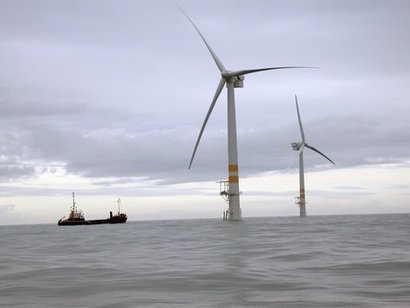
The plunge in activity in China, as the country shifts this year away from government-set tariffs to auctions for new wind and solar capacity, also depressed the 1H 2019 global investment figure – to $117.6 billion, down 14 percent compared to the first half of 2018.
The other highlight of global clean energy investment in 1H 2019 was the financing of multibillion-dollar projects in two relatively new markets – a solar thermal and photovoltaic complex in Dubai, at 950 MW and $4.2 billion, and two offshore wind arrays in the sea off Taiwan, at 640 MW and 900 MW and an estimated combined cost of $5.7 billion.
The Dubai deal in late March, for the Mohammed bin Rashid Al Maktoum IV project, is the biggest financing ever seen in the solar sector. It involves $2.6 billion of debt from 10 Chinese, Gulf and Western banks, plus $1.6 billion of equity from Dubai Electricity and Water Authority, Saudi-based developer ACWA Power and equity partner Silk Road Fund of China.
“The slowdown in investment in China is real, but the figures for first-half 2019 probably overstate its severity” said Justin Wu, head of Asia-Pacific for BNEF, commented. “We expect a nationwide solar auction happening now to lead to a rush of new PV project financings. We could also see several big deals in offshore wind in the second half.”
Jenny Chase, head of solar analysis for BNEF, added that Al Maktoum IV is an unusual one in combining three different types of solar – the thermal technologies of parabolic trough and tower, with conventional PV – but it is also a strong signal of the appetite for solar electricity on the part of both Middle Eastern countries and international financiers.”
The two Taiwanese offshore wind projects, Wpd Yunlin Yunneng and Ørsted Greater Changhua, involve European developers, investors and banks, as well as local players. Offshore wind activity is broadening its geographical focus, from Europe’s North Sea and China’s coastline, toward new markets such as Taiwan, the US East Coast, India and Vietnam.
BNEF’s figures for clean energy investment in the first half of 2019 show mixed fortunes for the world’s major markets. The “big three” of China, the U.S. and Europe all showed falls, but with the US down a modest 6 percent at $23.6 billion and Europe down 4 percent at $22.2 billion compared to 1H 2018, far less than China’s 39 percent setback.
Japan attracted $8.7 billion of investment, up 3 percent on 1H 2018, and India $5.9 billion, up 10 percent, as it continued its drive toward its ambitious target for 175 GW of renewable energy by 2022. Brazil saw investment of $1.4 billion, up 19 percent.
In Europe, Spain was the star performer at $3.7 billion, up 235 percent on the same period a year earlier, while the Netherlands was 41 percent lower at $2.2 billion, Germany down 42 percent at $2.1 billion, the U.K. up 35 percent at $2.5 billion and France down 75 percent at $567 million. Sweden saw investment jump 212 percent to $2.5 billion, and the Ukraine 60 percent to $1.7 billion.
Breaking global clean energy investment down by type of transaction, asset finance of utility-scale generation projects such as wind farms and solar parks was down 24 percent at $85.6 billion, due in large part to the China factor. Financing of small-scale solar systems of less than 1 MW was up 32 percent at $23.7 billion in the first half of this year.
Investment in specialist clean energy companies via public markets was 37 percent higher at $5.6 billion, helped by two big equity raisings for electric vehicle makers – an $863 million secondary issue for Tesla, and a $650 million convertible issue for China-based NIO.
Venture capital and private equity funding of clean energy companies in 1H 2019 was down 2 percent at $4.7 billion. There were three exceptionally large deals, however: $1 billion each for Swedish battery company Northvolt and US electric vehicle battery charging specialist Lucid Motors, and $700 million for another US EV player, Rivian Automotive.
For additional information:

